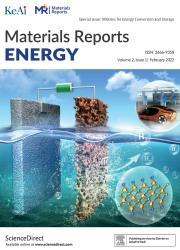Unveiling the effect of molybdenum and titanium co-doping on degradation and electrochemical performance in Ni-rich cathodes
IF 13.8
引用次数: 0
Abstract
In this work, we have applied molybdenum (Mo) and titanium (Ti) co-doping to solve the degradation of Ni-rich cathodes. The modified cathode, i.e., Li(Ni0.89Co0.05Mn0.05Mo0.005Ti0.005)O2 holds a stable structure with expanded crystal lattice distance which improves Li ion diffusion kinetics. The dopants have suppressed the growth of primary particles, formed a coating on the surface, and promoted the elongated morphology. Moreover, the mechanical strength of these particles has increased, as confirmed by the nanoindentation test, which can help suppress particle cracking. The detrimental H2-H3 phase transition has been postponed by 90 mV allowing the cathode to operate at a higher voltage. A better cycling stability over 100 cycles with 69% capacity retention has been observed. We believe this work points out a way to improve the cycling performance, Coulombic efficiency and capacity retention in Ni-rich cathodes.

揭示钼钛共掺杂对富镍阴极降解及电化学性能的影响
在这项工作中,我们应用钼(Mo)和钛(Ti)共掺杂来解决富镍阴极的降解问题。改性后的阴极Li(Ni0.89Co0.05Mn0.05Mo0.005Ti0.005)O2结构稳定,晶格距离扩大,提高了Li离子的扩散动力学。掺杂剂抑制了初生颗粒的生长,在表面形成一层涂层,促进了晶粒的伸长形貌。此外,纳米压痕试验证实,这些颗粒的机械强度有所提高,有助于抑制颗粒的开裂。有害的H2-H3相变被推迟了90 mV,使得阴极可以在更高的电压下工作。在100次循环中,有更好的循环稳定性,容量保留率为69%。我们认为这项工作为提高富镍阴极的循环性能、库仑效率和容量保持率指明了一条途径。
本文章由计算机程序翻译,如有差异,请以英文原文为准。
求助全文
约1分钟内获得全文
求助全文
来源期刊

材料导报:能源(英文)
Renewable Energy, Sustainability and the Environment, Nanotechnology
CiteScore
13.00
自引率
0.00%
发文量
0
审稿时长
50 days
 求助内容:
求助内容: 应助结果提醒方式:
应助结果提醒方式:


